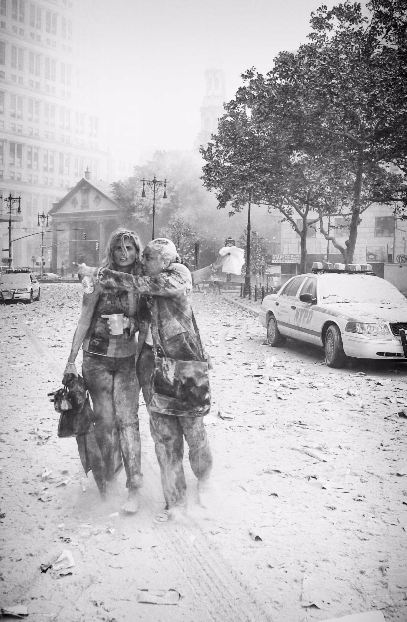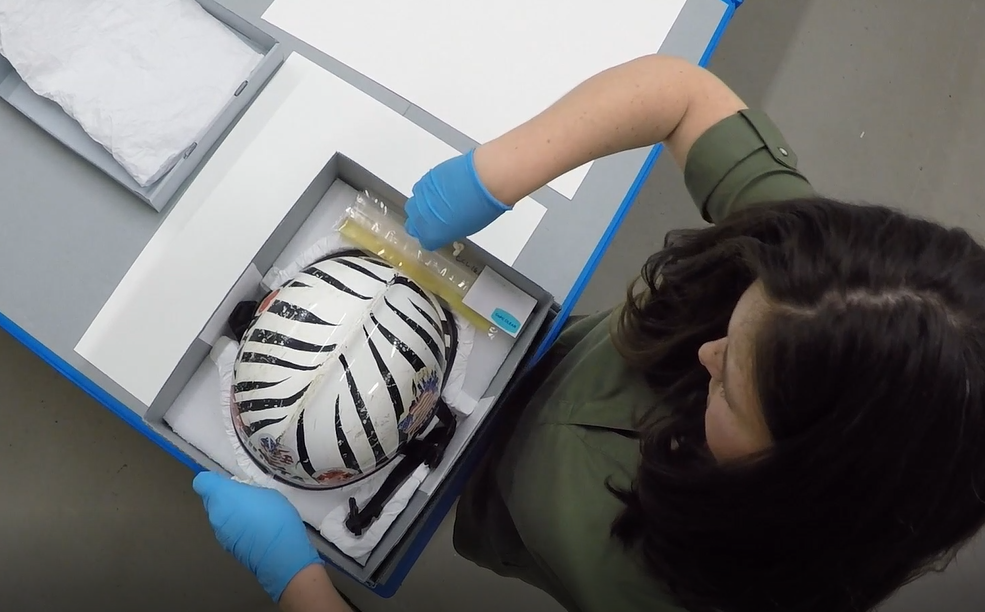Iconic Photo Brings Survivors Together Years After 9/11
Iconic Photo Brings Survivors Together Years After 9/11

Survivors of the 9/11 attacks have learned to cope with a range of trauma, from survivor guilt to post-traumatic stress disorder. But out of this pain emerged a wide-ranging community of evacuees ready to support one another. Today we are highlighting one such meaningful connection: the entwined stories of Joanne Capestro and Phil Penman, an office worker and a photographer whose lives intersected with the brief click of the camera shutter in a moment of chaos.
On Sept. 11, 2001, Joanne “JoJo” Capestro arrived to her job as an executive assistant at the May Davis Group on the 87th floor of the North Tower with a cup of take-out tea, feeling run down from a case of bronchitis.
At 8:46 a.m., a ferocious jolt toppled Capestro from her seat, spilling her tea. Falling ceiling tiles and jet fuel fumes propelled her to scout an exit with her coworkers to the nearest emergency stairwell – the only one on her floor left intact after Flight 11’s impact.
On the way down, Capestro says she was stuck by the order maintained in the stairwell, with civilians staying to the right and responders carrying heavy equipment moving up on the left. As they braved the gas fumes and uncomfortable heat, the May Davis party began to scatter during their descent. Separated from her colleagues, Capestro eventually reached street level around the same time that the South Tower collapsed, causing her to run in terror toward St. Paul’s Chapel.
Incredibly, when the debris cloud subsided, a friend from May Davis named Dominique also surfaced in the immediate vicinity. The two women decided to continue their escape together. Capestro in stockinged feet, staring straight ahead, her arm around her coworker, both caked in dust, suddenly emerged in the viewfinder of photographer Phil Penman.
Earlier that morning, Penman had been looking forward to his first day off after a strenuous six-months of nonstop work on assignment for Splash News. But after listening to a voice mail message left by a colleague urging him to investigate a breaking story about an airplane crash at the World Trade Center, Penman grabbed his camera and photo equipment and sped downtown on his bike.
Lower Manhattan was thronged with spectators, evacuating workers, ambulance teams treating those in distress and news crews jostling to report “on the scene.” Rather than elbow his way into the fray, Penman decided to concentrate on framing shots of the stricken towers juxtaposed against St. Paul’s Chapel in the foreground. Soon thereafter, he heard a loud crack followed by the unbelievable sight of the South Tower collapsing in his camera lens, with massive steel beams spilling to the ground.
“Life stopped on that day,” Penman remembers. “And then it restarted.”
Penman raced for shelter inside J & R Music World, on Park Row. Inside, he turned his camera on the surreal mixture of people in unsoiled business casualwear sheltering with those basted in ash. Returning to the street minutes later, Penman began snapping pictures as people – most appearing dazed and ghostly – emerged from the debris cloud. This is where he first encountered the woman later identified as Joanne Capestro.
The ensuing months were difficult for both Capestro and Penman. Capestro suffered from PTSD, survivor guilt and grief over the loss of her coworker, Harry Ramos, who was killed when the North Tower fell. Penman’s photos from September 11th were published internationally, but the hours of stress and spectacle he endured at the World Trade Center caused him continuing emotional pain.
“For a year straight I was having to photograph funerals, features with people who had lost loved ones and anything related to the ongoing story,” said Penman. “When I say difficult it’s not like I lost a loved one, but emotionally it really breaks you. Seeing such pain people are going through.”
Penman chose to show his work to the 9/11 Memorial Museum in 2016. While reviewing his images, the Museum’s curatorial staff spotted Capestro in several the shots he had taken. She previously had donated her dust-covered outfit from that day and the contents of her recovered pocketbook. They wondered if Penman might like to meet the stranger he had documented, and vice versa.
Penman and Capestro arranged that re-encounter over a year ago, at her downtown office. “I remember we both shared a hug when greeting each other and then chatted about our experiences since then. How our lives have changed from this experience,” said Penman.
Capestro says she thanked Penman for that photo. “That picture gave me a lot of closure,” she said.
The two are still in regular contact, and not surprisingly, they share a predilection for giving back and supporting their community.
Capestro has helped to raise more than $90,000 toward a Hurricane Harvey relief fund. A few years ago, she raised more than $165,000 for Hurricane Sandy relief efforts. For the past 14 years, she has been a team leader and a pace setter for the American Cancer Society’s annual breast cancer walk in Central Park.
“I always say that God left me here for a reason,” Capestro said. “FEMA and the 9/11 Fund really helped me, so I want to give back.”
Penman, too, keeps in touch with a number of people he photographed that fateful Tuesday. “It’s important to never forget that on 9/11 ‘we all came together,’” he said. “No matter what, there’s always someone in New York who can relate to that.”
By Anne Dellinger, Digital Communications Manager, 9/11 Memorial
Previous Post
The Sphere, a Symbol of Resilience After 9/11, Is Unveiled at Liberty Park

The iconic Koenig Sphere was unveiled on Wednesday morning at its new home at the World Trade Center’s Liberty Park. The Sphere, designed by German sculptor Fritz Koenig, became a symbol of hope and resilience following the 9/11 attacks.
Next Post
New Video Series Goes Behind the Scenes at 9/11 Memorial & Museum

The 9/11 Memorial & Museum has launched a new video series, “Mission to Remember.” These short documentaries go beyond the surface, immersing viewers in untold stories of honor and remembrance, and above all show the shared commitment to the mission behind the 9/11 Memorial & Museum.